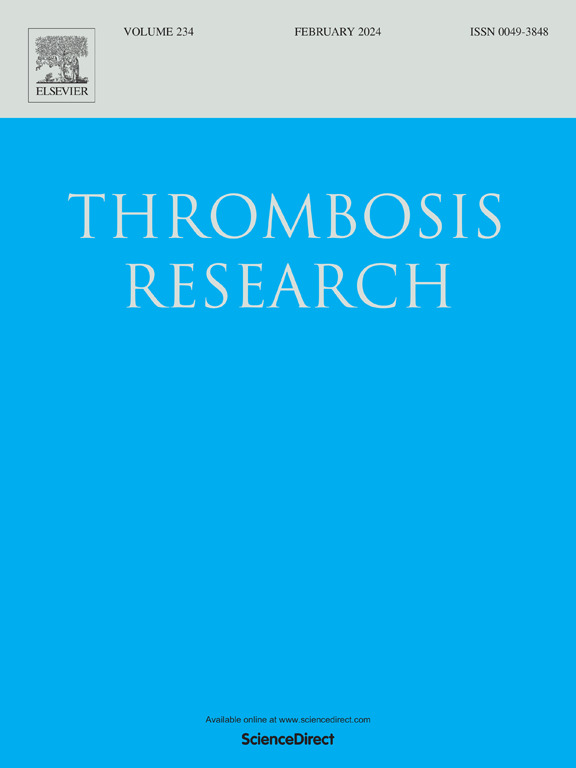弥散性血管内凝血溶解作为脓毒症相关弥散性血管内凝血死亡率的替代结果。
IF 3.4
3区 医学
Q1 HEMATOLOGY
引用次数: 0
摘要
脓毒症相关弥散性血管内凝血(DIC)可导致多器官功能障碍并增加死亡率。虽然DIC消退被认为是一个治疗目标,但其作为替代结果的有效性尚不清楚。识别DIC评分中的关键预后指标可以改善治疗策略。本研究旨在评估接受抗凝血酶治疗的脓毒症相关性DIC缓解与28 d死亡率之间的关系,并评估DIC评分成分的预后价值。本研究分析了2291例败血症相关DIC患者,使用了日本全国性抗凝血酶浓缩物上市后监测数据。使用生存分析和多变量模型来评估DIC分辨率、DIC评分组成部分和28 d死亡率之间的关系。DIC在第6天消退的患者28天死亡率明显低于持续性DIC患者。第3天的早期缓解与更好的生存率相关。血小板计数和凝血酶原时间-国际标准化比值(PT-INR)是死亡率的最强预测因子,而纤维蛋白/纤维蛋白原降解产物的预后价值有限。即使在持续性DIC患者中,PT-INR和血小板计数的改善也与更好的生存相关。高剂量抗凝血酶可提高DIC解析率,并有降低死亡率的趋势,尽管这种降低在统计学上并不显著。DIC消退与生存率的提高相关,可作为替代预后。监测关键凝血标志物,即使在未解决的情况下,可能有助于完善败血症相关DIC的治疗策略。这些发现可能支持未来针对脓毒症患者凝血功能障碍的临床试验。本文章由计算机程序翻译,如有差异,请以英文原文为准。

Disseminated intravascular coagulation resolution as a surrogate outcome for mortality in sepsis-associated disseminated intravascular coagulation
Sepsis-associated disseminated intravascular coagulation (DIC) contributes to multiple organ dysfunction and increases mortality. Although DIC resolution is considered a therapeutic goal, its validity as a surrogate outcome remains unclear. Identifying key prognostic markers within the DIC score may improve treatment strategies. This study aimed to evaluate the association between DIC resolution and 28-d mortality in patients with sepsis-associated DIC treated with antithrombin and to assess the prognostic value of DIC score components. This study analyzed 2291 patients with sepsis-associated DIC using data from a nationwide post-marketing surveillance of antithrombin concentrates in Japan. Survival analysis and multivariate models were used to assess the associations among DIC resolution, DIC score components, and 28-d mortality. Patients with resolved DIC by day 6 had a significantly lower 28-d mortality rate than those with persistent DIC. Early resolution by day 3 correlated with better survival. Platelet count and prothrombin time-international normalized ratio (PT-INR) were the strongest predictors of mortality, whereas fibrin/fibrinogen degradation product had limited prognostic value. Even among patients with persistent DIC, improvements in the PT-INR and platelet count were associated with better survival. High-dose antithrombin increased DIC resolution rates and showed a trend toward reduced mortality, although the reduction was not statistically significant. DIC resolution is associated with improved survival and may serve as a surrogate outcome. Monitoring key coagulation markers, even in unresolved cases, may help refine the treatment strategies for sepsis-associated DIC. These findings may support future clinical trials targeting coagulopathy in patients with sepsis.
求助全文
通过发布文献求助,成功后即可免费获取论文全文。
去求助
来源期刊

Thrombosis research
医学-外周血管病
CiteScore
14.60
自引率
4.00%
发文量
364
审稿时长
31 days
期刊介绍:
Thrombosis Research is an international journal dedicated to the swift dissemination of new information on thrombosis, hemostasis, and vascular biology, aimed at advancing both science and clinical care. The journal publishes peer-reviewed original research, reviews, editorials, opinions, and critiques, covering both basic and clinical studies. Priority is given to research that promises novel approaches in the diagnosis, therapy, prognosis, and prevention of thrombotic and hemorrhagic diseases.
 求助内容:
求助内容: 应助结果提醒方式:
应助结果提醒方式:


